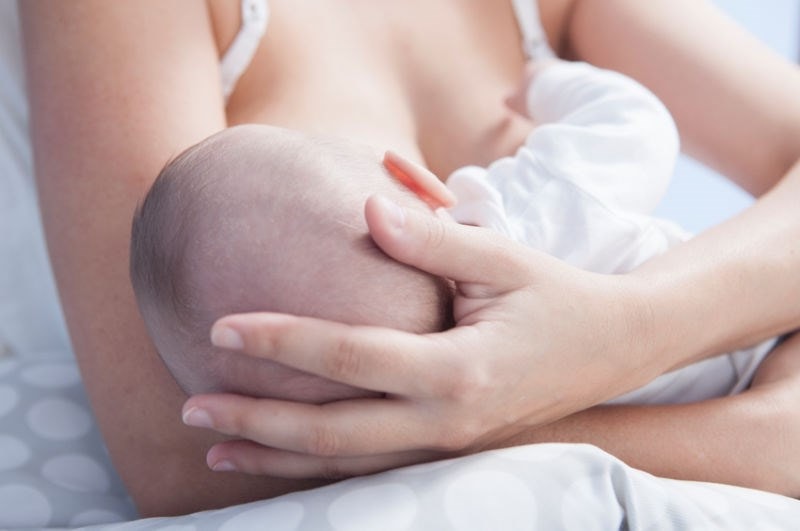Does Breastmilk Contain Probiotics?
Until recently, scientists have been unsure as to whether probiotics and prebiotics are found in a mother's breast milk, but recent research has indicated there is in fact an abundance of both.
Breast milk is produced in order to optimise the health and nutrition of a newborn, so breast milk contains proteins, fats, carbohydrates as well as nutrients, and various immune cells. We also now know that a mother's milk contains bacteria; the composition of which appears to change throughout the duration of lactation and varies between mothers.
In this article we will discuss:
- From the gut to the breast milk
- Probiotic supplement strains found in breast milk
- The breast microbiome

From the gut to the breast milk
The current 'shared' belief is that bacteria found in the breast milk originates in the mother's gut.
The transfer of maternal bacteria from the intestines to her breast milk is thought to be mediated by intestinal dendritic cells1. Dendritic cells penetrate the intestinal wall using long, string-like 'projections' and take up resident bacteria from within the gut.
These cells, containing a sample of the maternal intestinal microflora, then travel via the lymphatic system to other mucosal surfaces in the body, including the lactating mammary gland. Here the maternal microflora is secreted into the milk for uptake by the infant2. What a fascinating process!
Probiotic supplement strains found in breast milk
In fact, specific strains that have been consumed by the mum in the form of a probiotic have been found later in the breast milk!
In a study by Nasiraii et al (2011) Lactobacillus rhamnosus LC705 was given to 10 out of 20 women for 30 days. All the women in the study were breastfeeding 1-6 month old babies.
In the probiotic group, 4 of the 10 women were subsequently found to have this strain in their breast milk. Although this study is small, it is very encouraging to see that 40% of the probiotic group successfully transferred the supplemented probiotic strain into the breast milk3.
Hopefully, we will see larger studies like this in the probiotics industry in the near future. In the meantime, it is not a huge leap to speculate that other high quality probiotic strains taken by mothers could pass through to the breast milk, but we will welcome more research.
There are also some other interesting theories in relation to the translocation of bacteria from the gut to the breast milk. Jeurink et al (2013) suggests that hormonal changes facilitate the movement of bacteria. Progesterone may increase gut permeability to allow for the translocation of bacteria into the bloodstream, and finally to the mammary glands in the mother's breasts4.
The breast microbiome
The gut microbiome has received a lot of scientific attention in recent decades, and rightly so as this is the habitat of choice for a lot of the bacteria we share our bodies with, but there are also other notable microbiomes around our bodies, such as the skin.
Recently, a study published in the journal Scientific Reports has found that within a woman's breast lies a complex ecosystem of bacteria, much different to the skin outside, forming a distinct microbiome of it's own5. Further to this, the researchers found that the breast bacteria of women with and without breast cancer differ significantly. The scientists from the Mayo Clinic utilised DNA sequencing to analyse sterile breast tissue removed from 33 women. They then compared the results to the swabs taken from breast skin, as well as cheek swabs from the same patients.
The results from the samples revealed that the microorganisms found in women with healthy breast tissue (other than benign breast disease) differed to those with confirmed cancer diagnosis. The cancer patients had a higher abundance of a variety of bacteria such as Fusobacterium, Atopobium, and Lactobacillus, differing significantly from the skin microbiome. What's interesting about this specific study is that the samples were collected in a sterile operating theatre, unlike previous studies. However, it should also be noted that the study did not collect breast tissue from women without breast abnormalities of any kind.
The study's results are intriguing, but at this stage there are a lot more questions that need answering. What exactly does the presence, or lack of, certain bacteria in the breast microbiome mean? Is the presence of the bacteria indicative of the cause of the cancer, or do they colonise the breast tissue as a result of the cancer's development?
Previous studies have shown the Fusobacterium, one of the genera found in cancerous breast tissue, has previously been associated with colorectal cancers, but researchers say that more research is needed to determine exactly how the two may be linked. Tina Hieken, a Mayo Clinic oncologist and led researcher, commented:
"These bacteria might act by secreting virulence factors or by creating a pro-inflammatory environment. We'd like to look at what's really going on in the microenvironment of the tissue."
Additionally, research published in the Environmental Microbiology journal revealed that the same strains of bacteria were found in the breast milk and/or faeces of seven mother-baby pairs6. These types of bacteria, Bifidobacterium breve and several types of Clostridium, are key for bowel health and play a critical role in establishing nutritional balance in the infant gut, helping to prevent future digestive disorders.
The researchers investigated whether viable strains of anaerobic gut bacteria are shared between the maternal and neonatal gut flora via breastfeeding. The discovery that these bacteria are in fact shared between maternal faeces, breast milk and the faeces of newborn babies indicates that the beneficial bacteria can actually travel from a mother’s gut to her breast milk. This means that a specific strain among bacterial groups can potentially be carefully selected and used to support the establishment of healthy bacteria in the infant gut. The ability to select these specific strains could eventually help to reduce digestive problems such as colic, and help to promote a healthy gut. These advances could also enable formula milk manufacturers to better match human breast milk.
Very interesting findings in both cases, and we look forward to more clinical trials into this fascinating field of research.
Read more on related subjects:
Swabs of mum’s vaginal fluid may restore bacteria in Caesarian babies
References
- Olmstead et al (2007) Micrometabolic Imprinting in Infancy: Microflora, Probiotics & Chronic disease. Klaire Labs. Pg 1-5
- Rescigno M, et al. Dendritic cells express tight junction proteins and penetrate gut epithelial monolayers to sample bacteria. Nat Immunol 2001;2:361-7
- L. R. Nasiraii et al (2011) Investigation of Lactobacilli from mothers breast milk who were placed on probiotic diet. African Journal of Microbiology Research. Vol 5 (13) pp 1581-1585
- M. N-Ohayon et al (2016) Microbial changes during pregnancy, birth and infancy. Review. Frontiers in microbiology. Vol 7. Pg 1 – 11
- Hieken, T. J. et al. (2016) The Microbiome of Aseptically Collected Human Breast Tissue in Benign and Malignant Disease. Scientific Reports, 6; 30751,
- Jost, T., Lacroix, C., Braegger, C. P., Rochat, F. and Chassard, C. (2013), Vertical mother–neonate transfer of maternal gut bacteria via breastfeeding. Environmental Microbiology. doi: 10.1111/1462-2920.12238
- Ojima M et al., (2022) Priority effects shape the structure of infant-type Bifidobacterium communities on human milk oligosaccharides. The ISME Journal, 16: 2265-2279.
Popular Articles
View all Children's Health articles-
Children's Health16 Nov 2023
-
Children's Health12 Oct 2023


